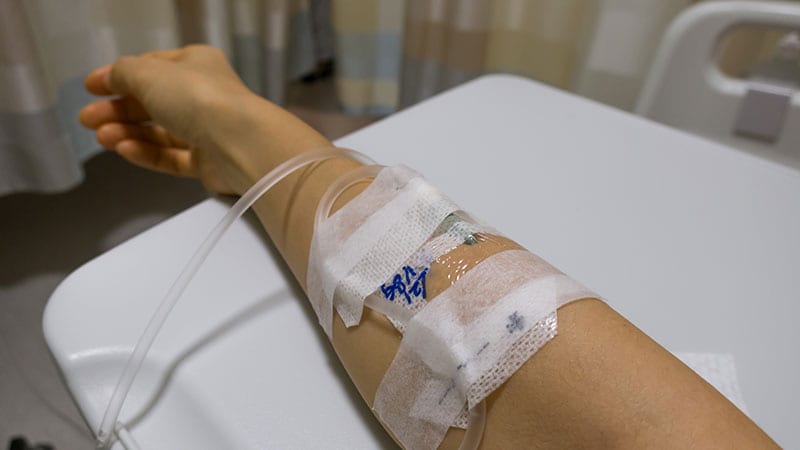Patients with multiple myeloma who receive intravenous immunoglobulin (IVIG) prophylaxis during treatment with teclistamab have fewer infections and better overall survival compared with those who do not receive IVIG prophylaxis, according to new findings presented here at the American Society of Hematology (ASH) 2024 Annual Meeting.
Among 225 consecutive patients who received at least one treatment for relapsed and/or refractory multiple myeloma, those who received IVIG prophylaxis experienced a significantly longer duration of infection-free survival and an almost threefold longer median overall survival compared with patients who did not receive IVIG prophylaxis.
IVIG supplementation has been shown to prevent severe infections in patients with multiple myeloma, but evidence on the best time to initiate IVIG prophylaxis among those receiving teclistamab remains less clear.
“Our institutional practice is to start IVIG about cycle 2 of therapy, which ended up being around 39 days,” but a key takeaway from the current findings is to “start IVIG within 30 days,” said lead investigator Heloise Cheruvalath, BA, a medical student at Medical College of Wisconsin, Milwaukee, who presented the findings.
The 225 patients included in the study had received at least one dose of standard-of-care teclistamab or an investigational B-cell maturation antigen (BCMA)-directed bispecific antibody (bsAb). IVIG was given as prophylaxis to 92 patients (41%) in the primary arm. The remaining 133 patients (59%) did not receive IVIG prophylaxis, but 29% received IVIG after a documented infection.
In total, there were 288 infections in 136 patients, and about 61% of infections required hospitalization. Median time to infection was 97 days, with the 12-month cumulative incidence of all-grade infections reaching 73% and the incidence of grade 3 or higher infections totaling 53%. Respiratory tract infections were the most common infection type, with COVID-19 accounting for 11% of cases, Cheruvalath noted.
Comparing patients who did and did not receive IVIG prophylaxis, median infection-free survival was significantly longer in the prophylaxis group — a median of 7.7 months versus 3 months — as was grade 3 or higher infection-free survival — a median of 14 months versus 7.5 months.
IVIG prophylaxis also led to a higher rate of 2-year progression free survival in the prophylaxis versus nonprophylaxis group — at 38% versus 32% — as well as longer median progression free survival — at 15 months versus 8 months.
After multivariate analysis, IVIG prophylaxis was no longer significantly associated with improved progression free survival.
However, median overall survival did remain significantly better in the IVIG prophylaxis than nonprophylaxisgroup after multivariate analysis — 44 months versus 16 months. The presence of high-risk and extramedullary disease was independently associated with worse overall survival.
The effects of IVIG prophylaxis were stronger for bacterial infections at earlier (30 days or sooner) versus later (31 days or later) time points, but timing of IVIG therapy did not appear to affect the incidence of viral infections.
A study limitation was lack of randomization; IVIG prophylaxis was given at the physician’s discretion. In addition, multiple myeloma treatment was not standardized, with 15% of IVIG patients and 38% of non-IVIG patients receiving investigational BCMA bsAB.
“However, the majority of those who received primary IVIG prophylaxis were treated with standard-of-care teclistamab, making our results generalizable to current clinical practice,” Cheruvalath said.
Rahul Banerjee, MD, who was not involved with the research, noted he has already started providing routine IVIG prophylaxis based on earlier research from this group. “Before I did, my patients would often get very rare infections requiring protracted courses of antibiotics,” Banerjee, from Fred Hutch Cancer Center, University of Washington School of Medicine, Seattle told Medscape Medical News. “Moving to IVIG before the infections start makes much more sense.”
Banerjee also commented that, in general, “the myeloma field has been moving from IV treatments to subcutaneous treatments to lower ‘time toxicity’ and IVIG is a notable exception to that trend, but perhaps it won’t be this way forever.”
Many patients with rheumatologic conditions receive subcutaneous immunoglobulin, in some cases, with kits they can self-administer at home, Banerjee said, and “I know some groups are starting to work on moving subcutaneous immunoglobulin to the oncologic setting.”
Funding was provided by the Advancing Healthier Wisconsin Endowment. Cheruvalath has reported no relevant disclosures. Banerjee has reported consulting for Adaptive Biotechnologies, Bristol Myers Squibb, Caribou Biosciences, Genentech, GSK, Johnson & Johnson/Janssen, Karyopharm, Legend Biotech, Pfizer, Sanofi, and SparkCures; and receiving research funding from AbbVie, Johnson & Johnson, Novartis, Pack Health, Prothena, and Sanofi.
Kate Johnson is a Montreal-based freelance medical journalist who has been writing for more than 30 years about all areas of medicine.
Source link : https://www.medscape.com/viewarticle/ivig-prophylaxis-multiple-myeloma-cuts-infections-boosts-2024a1000mlw?src=rss
Author :
Publish date : 2024-12-08 18:20:03
Copyright for syndicated content belongs to the linked Source.
